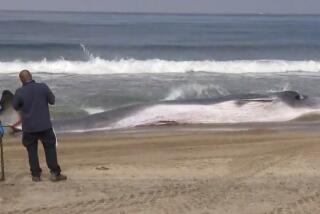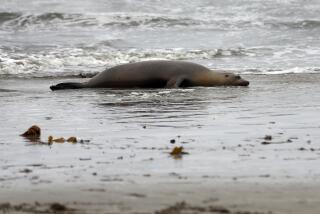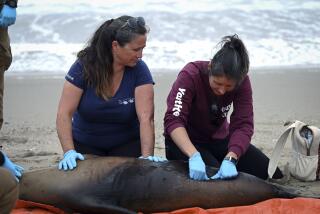Wave of Beachings Baffles Experts : Marine life: Scientists are trying to discover why an unusually large number of whales and dolphins have become stranded along the Central Coast.
SAN FRANCISCO — In an unusual episode that is baffling scientists and upsetting beach-goers, two dozen dolphins and sperm whales have washed ashore along a 110-mile stretch of California’s Central Coast, sparking an intensive hunt for a cause.
The mysterious strandings, which began April 3, have been clustered in San Luis Obispo and Santa Barbara counties, between San Simeon and Refugio State Beach. All but three of the marine mammals have died.
“At this point, we have no idea what’s going on,” said James Lecky, chief of the protected species division at the National Marine Fisheries Service. “There are no common symptoms, no obvious causes of death. What we do know is that these strandings are occurring at a much higher frequency than we expect to see.”
Last year, marine scientists recorded fewer than 30 strandings of common dolphins and sperm whales along the entire California shoreline. In the five weeks since this spring’s wave of beachings began, 21 dolphins and three whales have washed ashore.
In response, volunteers in a statewide marine mammal stranding network have rushed to the Central Coast, rescuing the victims and collecting the dead for laboratory studies that may reveal clues.
Although the species’ population levels are strong, scientists worry that the deaths could be an indicator of disease or the presence of toxic substances, either naturally occurring or people-related.
“We don’t need to go into a panic mode yet, but we’re certainly concerned and we need to figure this out,” said John Heyning, curator of marine mammals at the Los Angeles County Museum of Natural History.
This week, Heyning will perform necropsies on several carcasses, hunting for diseased organs or other obvious explanations of mortality. Scientists elsewhere are conducting lab work, including toxicology tests to look for the presence of heavy metals or other contaminants. Unraveling the mystery could take months or years, experts say.
Theories about the beachings abound. One possibility is that shifts in ocean currents have redistributed the species’ food source, forcing them closer to shore to feed. If that is the case, the strandings could simply be evidence of natural deaths that would usually occur at sea, Lecky said.
A “red tide” of toxins, caused by algae blooms, is another suspect, and a disease epidemic could also be to blame. In the late 1980s, 2,500 Atlantic bottlenosed dolphins died of a virus that was not identified until years later. So far, that culprit--the morbillivirus --has not been detected on the West Coast, and tests for it on one of the surviving dolphins were negative.
Along the Central Coast, some residents see a connection with a massive spill of petroleum thinner at an oil field owned by Unocal Corp. The site of the 8.5-million-gallon spill--which occurred over a period of 40 years and was only acknowledged by Unocal in March--is three miles south of Pismo Dunes, where seven mammals washed up.
The state Department of Fish and Game plans to conduct tests to uncover a possible relationship with the spill, but scientists do not believe that one exists. The petroleum, they say, would probably have evaporated or become diluted before reaching the dolphins and sperm whales feeding offshore.
“I’m not ruling it out, but I would think we’d have seen die-offs of birds and other more susceptible animals” if the oil were to blame, Heyning said.
The sperm whale--memorialized in fiction by the mighty Moby Dick--is the largest of the toothed whales, with males reaching up to 60 feet in length. Sperm whales are also among the deepest- and longest-diving mammals in the sea, able to plunge 6,000 feet and remain submerged for up to 90 minutes. None of the beached whales survived.
The dolphins that have washed ashore include two species--the long-beaked and short-beaked common dolphin. Known to form exceptionally large schools, they are the most common cetaceans found off California.
Neither the sperm whale nor the common dolphin is endangered. There are an estimated 750 sperm whales in the state’s waters, Heyning said, and about 240,000 common dolphins.
Despite those numbers, a beached mammal--especially one flopping futilely on the sand--is a distressing sight. At Pismo Dunes, beach-goers encountering the seafaring victims have been pretty upset, said Don Patton, superintendent of the state recreation area.
“We see quite an emotional response because you don’t find these animals lying around in our artificial world very often,” Patton said. “These things have washed up in popular areas of the beach, and with the live ones, we’ve had large numbers of people in the water, trying to coax them back out to sea.”
Encouraging a distressed mammal to return to the ocean is not necessarily advised. Although beachings remain one of nature’s mysteries, experts say creatures that wash ashore are typically too weak, diseased or disoriented to swim.
“In my opinion, they just hit the shore and are too sick and confused to do anything about it,” said Heyning, who has studied hundreds of strandings.
For that reason, most mammals that wash ashore die before volunteers from California’s marine mammal stranding network can race to their aid, said Joe Cordaro, a federal wildlife biologist and coordinator of the network. Even if rescuers arrive in time, he said, the journey to a rehabilitation site is stressful, and often fatal.
In this instance, three dolphins remain alive. Two were driven to San Diego’s Sea World--traveling on foam pads in the back of a truck, where attendants kept them covered with wet towels and made sure their blowholes were clear. Sea World’s curator of mammals said the dolphins are in stable but poor condition, with one requiring assistance to eat and another receiving antibiotics for an infection.
The third survivor--named “Catalina Bob” by his rescuers and “C53,” for Cetacean 53, by scientists--is doing better, recuperating at Marine World/Africa USA in the Bay Area.
Krista Hanni, science director for the Marine Mammal Center in Sausalito, which deploys volunteer rescuers, pronounced Bob “in good shape.”
“Diagnostic tests turned up nothing conclusive,” she said. “If all goes well, we hope to release Bob in Monterey Bay on Monday.”
More to Read
Sign up for Essential California
The most important California stories and recommendations in your inbox every morning.
You may occasionally receive promotional content from the Los Angeles Times.










